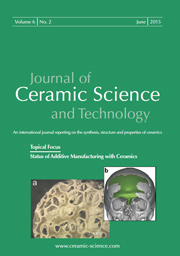Articles
All articles | Recent articles
Impact of Feedstock Nature on Thermal Conductivity of YSZ Thermal Barrier Coatings Obtained by Plasma Spraying
P. Carpio1,2, M.D. Salvador1, R.Benavente1, M. Miranda3, A. Borrell1, E. Sánchez2
1 Instituto de Tecnología de Materiales (ITM), Universitat Politècnica de València. Camino de Vera sn/, 46022 Valencia, Spain
2 Instituto de Tecnología Cerámica (ITC), Universitat Jaume I. Campus Universitario Riu Sec, Av. Sos Baynat s/n, 12006 Castellón, Spain
3 Centre for Advanced Structural Ceramics (CASC), Department of Materials, Imperial College London. South Kensington Campus, London SW7 2AZ, UK
received March 15, 2016, received in revised form May 3, 2016, accepted May 27, 2016
Vol. 7, No. 3, Pages 307-312 DOI: 10.4416/JCST2016-00022
Abstract
Yttria-stabilized zirconia (YSZ) coatings with low thermal conductivity were obtained using three different particle size distributions as starting powder: nano-, submicron- and bimodal submicron/nano-sized particles. On the one hand, these particles were reconstituted into micrometric, spray-dry agglomerates, which were subsequently deposited by means of conventional atmospheric plasma spraying (APS). On the other hand, the starting particles were dispersed in water and the resultant suspensions were deposited by means of suspension plasma spraying (SPS). The coatings were thermally treated to assess their sintering resistance. As-sprayed and thermally treated coatings were then characterized in terms of microstructure (FEG-SEM) and thermal diffusivity (laser flash equipment).
The results showed that SPS coatings exhibited extremely low thermal conductivity at low temperature which drastically augmented with increasing temperature. On the other hand, APS coatings also exhibited low thermal conductivities but their values were higher than those of the SPS coatings at the lowest temperature tested while the conductivities hardly varied with temperature.
![]() Download Full Article (PDF)
Download Full Article (PDF)
Keywords
Thermal barrier coatings, yttria-stabilized zirconia, microstructure, thermal conductivity, atmospheric plasma spraying
References
1 Padture, N.P., Gell, M., Jordan, E.H.: Thermal barrier coatings for gas-turbine engine applications, Science, 296, 280 – 284, (2002).
2 Tian, Y.S., Chen, C.Z., Wang, D.Y., Ji, Q.: Recent developments in zirconia thermal barrier coatings, Surf. Rev. Lett., 12, 369 – 378, (2005).
3 Curry, N., Markocsan, N., Li, X.H., Tricoire, A., Dorfman, M.: Next generation thermal barrier coatings for the gas turbine industry, J. Therm. Spray Techn., 11, 108 – 115, (2011).
4 Wang, Y., Wu, W., Zheng, X., Zeng, Y., Ding, M., Zhan, C.: Relationship between the microstructure and thermal conductivity of plasma-sprayed ZrO2 coatings, J. Therm. Spray Techn., 20, 1177 – 1182, (2011).
5 Tan, Y., Sriniwasan, V., Nakamura, T., Sampath, S., Bertrand, P., Bertrand, G.: Optimizing compliance and thermal conductivity of plasma sprayed thermal barrier coatings via controlled powders and processing strategies, J. Therm. Spray Techn., 21, 950 – 962, (2012).
6 Pawłowski, P., Fauchais, P.: Thermal transport properties of thermally sprayed coatings, Int. Mater. Rev., 37, 271 – 289, (1992).
7 Fauchais, P., Montavon, G., Lima, R.S., Marple, B.R..: Engineering a new class of thermal spray nano-based microstructures from agglomerated nanostructured particles, suspensions and solutions: an invited review, J. Phys. D Appl. Phys., 44, 093001, (2011).
8 Pawłowski, L.: Finely grained nanometric and submicrometric coatings by thermal spraying: A review, Surf. Coat. Technol., 202, 4318 – 4328, (2008).
9 Lima, R.S., Marple, B.R.: Thermal spray coatings engineered from nanostructured ceramic agglomerated powders for structural, thermal barrier and biomedical applications: A review, J. Therm. Spray Techn., 16, 40 – 63, (2007).
10 Carpio, P., Blochet, Q., Pateyron, B., Pawłowski, L., Salvador, M.D., Borrell, A., Sánchez, E.: Correlation of thermal conductivity of suspension plasma sprayed yttria stabilized zirconia coatings with some microstructural effects, Mater. Lett., 107, 370 – 373, (2013).
11 VanEvery, K., Krane, J.M., Trice, R.W., Wang, H., Porter, W., Besser, M.: Column formation in suspension plasma-sprayed coatings and resultant thermal properties, J. Therm. Spray Techn., 20, 817 – 28, (2011).
12 Carpio, P., Moreno, R., Gómez, A., Salvador, M.D., Sánchez, E.: Role of suspension preparation in the spray drying process to obtain nano/submicrostructured YSZ powders for atmospheric plasma spraying, J. Eur. Ceram. Soc., 35, 237 – 247, (2015).
13 Vicent, M., Sánchez, E., Moreno, A., Moreno, R.: Preparation of high solids content nano-titania suspensions to obtain spray-dried nanostructured powders for atmospheric plasma spraying, J. Eur. Ceram. Soc., 32, 185 – 194, (2012).
14 Carpio, P., Bannier, E., Salvador, M.D., Borrell, A., Moreno, R., Sánchez, E.: Effect of particle size distribution of suspension feedstock on the microstructure and mechanical properties of suspension plasma spraying YSZ coatings, Surf. Coat. Technol., 268, 293 – 297, (2015).
15 Lide, D.R.: CRC handbook of chemistry and physics. CRC, Boca Raton, 2008.
16 West Conshohocken, P.A.: Standard test method for thermal diffusivity by the flash method. ASTM Standard E1461 – 11, (2012).
17 Bacciochini, A., Montavon, G., Ilavsky, J., Denoirjean, A., Fauchais, P.: Porous architecture of SPS thick YSZ coatings structured at the nanometer scale (∼50 nm), J. Therm. Spray Techn., 19, 198 – 206, (2010).
18 Lima, R.S., Marple, B.R., Nanostructured YSZ thermal barrier coatings engineered to counteract sintering effects, Mater. Sci. Eng. A, 485, 182 – 193, (2007).
Copyright
Göller Verlag GmbH


